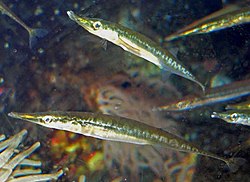Since our last video posting, many of the videos on our lab’s Youtube channel have gone viral. As of this blog post, the video of Inermia vitatta has accrued over 120,000 hits and has been featured on TV programs and newspaper articles around the globe. Not bad for a small fish!
[youtube=http://www.youtube.com/watch?v=psdLbN7skg4]Today’s video features the threespine stickleback, Gasterosteus aculeatus, feeding on a cladoceran (Daphnia pulex). If you have a short attention span like me, one of the first things you’ll notice from the video is how shiny the fish is. The reflective armor plates and large spines are a clue that this is a threespine stickleback from an anadromous population. Anadromous stickleback have a life history similar to a miniature salmon – they are born in freshwater, travel to the ocean, then return to freshwater to breed. Unlike salmon, anadromous stickleback do not necessarily return to their home stream to breed. Anadromous stickleback also look very similar to each other – an Alaska anadromous fish looks very similar to a California anadromous fish.
Sometimes, these anadromous stickleback will travel to a newly-formed lake or river, and instead of returning to the ocean, some fish will stay in freshwater, founding a new population of freshwater stickleback. Over time, this freshwater population will evolve to better match its new freshwater habitat.
These anadromous and freshwater populations are one of the reasons stickleback are such a good system for studying evolutionary biology. We can study the result of rapid evolution in the freshwater populations, and then turn around and study the anadromous fish that resemble the fish that founded the freshwater population. Studying ancestral and derived populations is one of the few ways – short of a time machine – that we can learn the dynamics of adaptation in natural populations.
If we study how this anadromous stickleback captures prey, and then study how freshwater stickleback catch prey, we can learn a lot about the process of adaptation. I’ve devoted much of my PhD work to studying this system, and I’ll be talking more about it in future posts.






